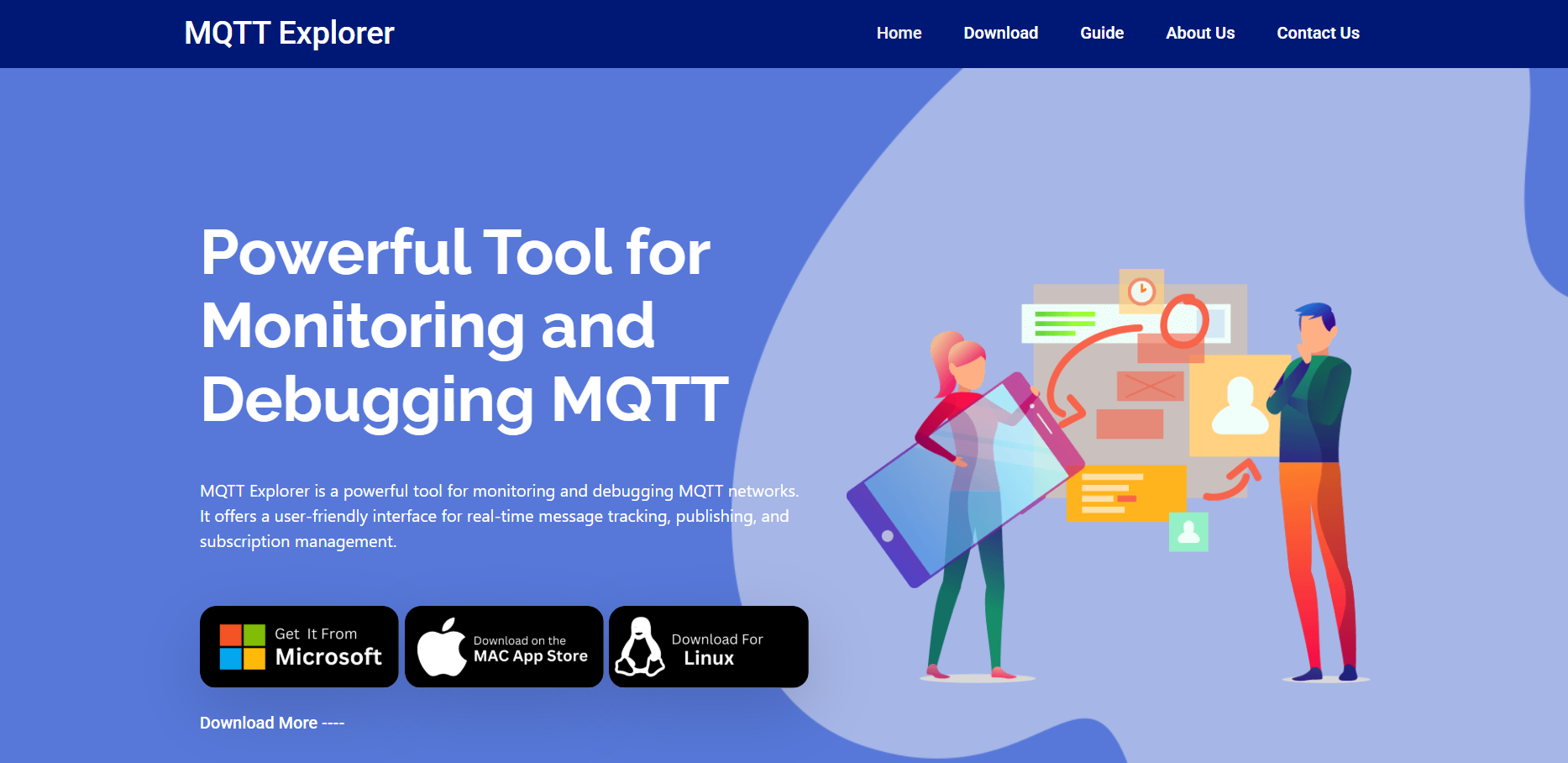MQTT, or Message Queuing Telemetry Transport, is a lightweight messaging protocol widely used in IoT (Internet of Things), smart home systems, and industrial automation. While the protocol is efficient, debugging MQTT traffic can become challenging without the right tools. Enter MQTT Explorer, a graphical tool explicitly designed for visualizing, debugging, and interacting with MQTT data flows.
Whether you’re a developer working on MQTT-based systems, a system integrator, or an IoT enthusiast, understanding how MQTT Explorer fits into your toolkit can save hours of frustration. Let’s break down how this tool works and why it’s considered a go-to solution for MQTT debugging.
MQTT Protocol in Action
Before diving into the debugging process, it’s important to grasp the basics of the MQTT protocol. MQTT operates on a publish-subscribe model, where:
- Clients either publish data to specific topics or subscribe to topics to receive data.
- A central broker manages message distribution between clients.
This model enables loose coupling between devices, which is ideal for constrained networks, such as those in IoT environments. However, this abstraction makes it tricky to trace data flows and identify faults manually.
Challenges in MQTT Debugging
Debugging MQTT interactions manually or through code-level logging can introduce several difficulties:
- Hidden Payloads: MQTT messages often contain binary or JSON payloads that are hard to interpret without visualization.
- Silent Failures: Issues like wrong topic names or broker disconnections might not throw explicit errors.
- Scalability Complexity: In large IoT deployments, tracking which client published what, and when, becomes overwhelming.
- Lack of Real-Time Feedback: Without a dynamic monitoring interface, developers must rely on logs and indirect cues.
A tool that visualizes MQTT topics, payloads, and QoS levels in real-time can eliminate much of this guesswork. That’s where MQTT Explorer steps in.
MQTT Explorer Overview
MQTT Explorer is a cross-platform desktop application that connects to an MQTT broker and displays the full topic structure in a hierarchical tree. It supports advanced features like:
- Topic filtering and searching
- JSON and text payload visualization
- Real-time message monitoring
- Retained message inspection
- Subscription to wildcard topics
- QoS level monitoring
Developed with a user-friendly GUI, MQTT Explorer enables intuitive interaction with live MQTT networks, even for beginners.
Real-Time Topic Visualization
One of the standout features of MQTT Explorer is its topic tree visualization. When connected to a broker, the application automatically maps incoming topics into an expandable tree. This tree-like view is not just aesthetic; it provides critical debugging advantages:
- Instant Context: See the exact topic hierarchy and structure at a glance.
- Pattern Recognition: Easily spot missing or misnamed topics that could lead to failed subscriptions.
- Stream Filtering: Narrow the view to a specific branch of topics using filters, making large-scale debugging manageable.
This organized view helps developers catch errors they might otherwise miss using command-line tools or embedded logs.
JSON and Payload Parsing
MQTT payloads often contain structured data in JSON format. MQTT Explorer comes equipped with a built-in JSON parser, which presents data in an indented, color-coded format. This makes it significantly easier to:
- Understand data structures
- Spot null or missing values
- Compare payloads across different messages
- Debug data formatting issues
Even non-JSON payloads are presented in readable formats, with support for text and hexadecimal display. This eliminates the need for additional parsing tools or browser-based viewers.
Subscription and Publish Tools
MQTT Explorer is not just a passive listener. It includes tools for:
- Subscribing to individual or wildcard topics
- Publishing custom messages to any topic
- Adjusting Quality of Service (QoS) levels
- Toggling the retained flag on messages
This interactivity allows developers to simulate real-world MQTT scenarios during debugging sessions. For instance, you can publish test payloads to a topic and observe how different clients respond. You can also verify if a client correctly handles retained messages on startup.
The ability to publish and subscribe within a single UI speeds up debugging cycles and facilitates end-to-end testing without code changes.
Retained Message Inspection
MQTT retained messages can be a source of subtle bugs, especially in persistent systems. MQTT Explorer highlights retained messages clearly in the topic tree. Developers can:
- View retained flags next to topic entries
- Manually delete retained messages
- Publish new retained values to reset state
This feature is particularly helpful when debugging device provisioning or state synchronization workflows, where incorrect retained values can cause clients to misbehave upon reconnection.
Wildcard Topic Support
Wildcards are integral to MQTT subscriptions, allowing a client to listen to multiple topics simultaneously. MQTT Explorer supports both:
- + for single-level wildcards
- # for multi-level wildcards
This capability lets developers observe all messages within a topic branch or across the entire broker, depending on subscription scope. Wildcard support is crucial during large-scale system tests or when diagnosing issues in systems with hundreds of topic variations.
Connection Debugging and TLS Support
Connectivity is the foundation of MQTT communication. MQTT Explorer includes detailed connection settings such as:
- Broker host and port
- Client ID customization
- Authentication with username and password
- TLS/SSL encryption options
- CA certificate importing
During connection issues, MQTT Explorer provides verbose logs and status messages. This helps pinpoint problems like:
- Certificate mismatches
- Port blocking by firewalls
- Incorrect credentials
TLS support ensures that the tool can be used in production-grade environments with secure brokers.
Performance with Large Brokers
Even when connected to brokers managing thousands of messages per second, MQTT Explorer maintains smooth performance. It allows:
- Throttling of message rate
- Selective topic expansion
- Memory-efficient message caching
These features prevent system slowdowns during intensive debugging sessions. Developers can confidently use MQTT Explorer with commercial brokers like Mosquitto, HiveMQ, EMQX, and AWS IoT Core.
Cross-Platform Availability
MQTT Explorer is built using Electron, which ensures it runs on:
- Windows
- macOS
- Linux
Installation is straightforward via installers or package managers. This flexibility allows team members on different operating systems to use a consistent debugging tool.
Practical Debugging Use Cases
IoT Device Provisioning
When provisioning a new IoT device, MQTT Explorer can help verify:
- Correct topic format on publish
- Retained state updates
- Device responses to configuration messages
Faulty Sensor Diagnosis
For sensors that stop reporting, MQTT Explorer can reveal:
- Whether messages are reaching the broker
- If the sensor is connected and publishing regularly
- Any malformed payloads causing processing errors
Broker Migration Testing
When switching brokers or scaling up infrastructure, MQTT Explorer is useful for:
- Comparing behavior across two brokers
- Ensuring topics and retained messages transfer correctly
- Testing SSL configurations and client certificates
Advantages Over CLI Tools
While command-line tools like mosquitto_pub and mosquitto_sub are valuable, MQTT Explorer offers superior usability for debugging:
| Feature | CLI Tools | MQTT Explorer |
| Topic Tree Visualization | ❌ | ✅ |
| Real-Time Message Parsing | ❌ | ✅ |
| JSON Payload Formatting | ❌ | ✅ |
| GUI-Based Interactions | ❌ | ✅ |
| Multiple Subscriptions UI | ❌ | ✅ |
| Retained Message Handling | Partial | ✅ |
For comprehensive debugging, MQTT Explorer complements CLI tools and brings clarity to otherwise opaque MQTT systems.
Common Pitfalls Avoided with MQTT Explorer
By using MQTT Explorer, developers can proactively avoid:
- Incorrect topic paths that silently fail
- Duplicate subscriptions
- Accidental overwrites of retained messages
- Misconfigured TLS settings
- Undetected broker disconnections
The visual feedback and robust error messages make it significantly easier to identify and correct these issues.
Limitations and Considerations
Despite its strengths, MQTT Explorer may not be the best fit for all situations:
- Resource-intensive: As an Electron app, it may consume more memory than CLI alternatives.
- Not for Embedded Systems: It’s a desktop tool, so it can’t run on constrained environments like Raspberry Pi Zero without a GUI.
- No Automation: Unlike scripting tools, it doesn’t offer automation or batch processing features.
For automated testing or headless debugging, combining MQTT Explorer with CLI tools or custom scripts can yield optimal results.
Final Thoughts
MQTT Explorer has proven itself as a powerful, easy-to-use debugging tool for MQTT networks. Its visual interface, real-time data parsing, and interactive controls make it ideal for developers and testers alike. Whether you’re working on a smart thermostat, a fleet of industrial sensors, or a cloud-connected device ecosystem, MQTT Explorer delivers the visibility and control needed to debug MQTT traffic efficiently.







